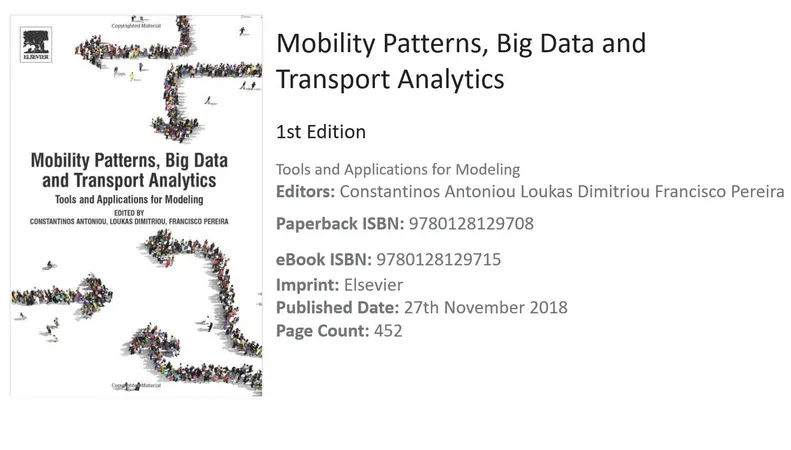Book
Mobility Patterns, Big Data and Transport Analytics - 1st Edition

Book pages in publisher website:
Mobility Patterns, Big Data and Transport Analytics. Tools and Applications for Modeling
Description
Mobility Patterns, Big Data and Transport Analytics provides a guide to the new analytical framework and its relation to big data, focusing on capturing, predicting, visualizing and controlling mobility patterns - a key aspect of transportation modeling. The book features prominent international experts who provide overviews on new analytical frameworks, applications and concepts in mobility analysis and transportation systems. Users will find a detailed, mobility ‘structural’ analysis and a look at the extensive behavioral characteristics of transport, observability requirements and limitations for realistic transportation applications and transportation systems analysis that are related to complex processes and phenomena.
This book bridges the gap between big data, data science, and transportation systems analysis with a study of big data’s impact on mobility and an introduction to the tools necessary to apply new techniques.
The book covers in detail, mobility ‘structural’ analysis (and its dynamics), the extensive behavioral characteristics of transport, observability requirements and limitations for realistic transportation applications, and transportation systems analysis related to complex processes and phenomena. The book bridges the gap between big data, data science, and Transportation Systems Analysis with a study of big data’s impact on mobility, and an introduction to the tools necessary to apply new techniques.
Key Features
- Guides readers through the paradigm-shifting opportunities and challenges of handling Big Data in transportation modeling and analytics
- Covers current analytical innovations focused on capturing, predicting, visualizing, and controlling mobility patterns, while discussing future trends
- Delivers an introduction to transportation-related information advances, providing a benchmark reference by world-leading experts in the field
- Captures and manages mobility patterns, covering multiple purposes and alternative transport modes, in a multi-disciplinary approach
- Companion website features videos showing the analyses performed, as well as test codes and data-sets, allowing readers to recreate the presented analyses and apply the highlighted techniques to their own data
Readership
Transport researchers, practitioners, and consultants, Undergraduate and graduate students in transportation programs, Transport policy makers.
Table of Contents
Chapter 1 - Big Data and Transport Analytics: An Introduction
Part I: Methodological
Chapter 2 - Machine Learning Fundamentals
Chapter 3 - Using Semantic Signatures for Social Sensing in Urban Environments
Chapter 4 - Geographic Space as a Living Structure for Predicting Human Activities Using Big Data
Chapter 5 - Data Preparation
Chapter 6 - Data Science and Data Visualization
Chapter 7 - Model-Based Machine Learning for Transportation
Case Study 1: Taxi Demand in New York City
Case Study 2: Travel Mode Choices
Case Study 3: Freeway Occupancy in San Francisco
Case Study 4: Incident Duration Prediction
Chapter 8 -Textual Data in Transportation Research: Techniques and Opportunities
Part II: Applications
Chapter 9 - Statewide Comparison of Origin-Destination Matrices Between California Travel Model and Twitter
Chapter 10 - Transit Data Analytics for Planning, Monitoring, Control, and Information
Chapter 11 - Data-Driven Traffic Simulation Models: Mobility Patterns Using Machine Learning Techniques
Chapter 12 - Big Data and Road Safety: A Comprehensive Review
Chapter 13 - A Back-Engineering Approach to Explore Human Mobility Patterns Across Megacities Using Online Traffic Maps
Chapter 14 - Pavement Patch Defects Detection and Classification Using Smartphones, Vibration Signals and Video Images
Chapter 15 - Collaborative Positioning for Urban Intelligent Transportation Systems (ITS) and Personal Mobility (PM): Challenges and Perspectives